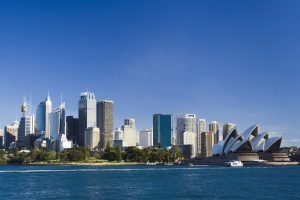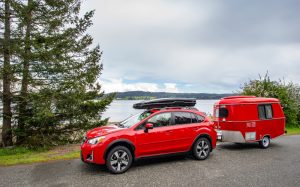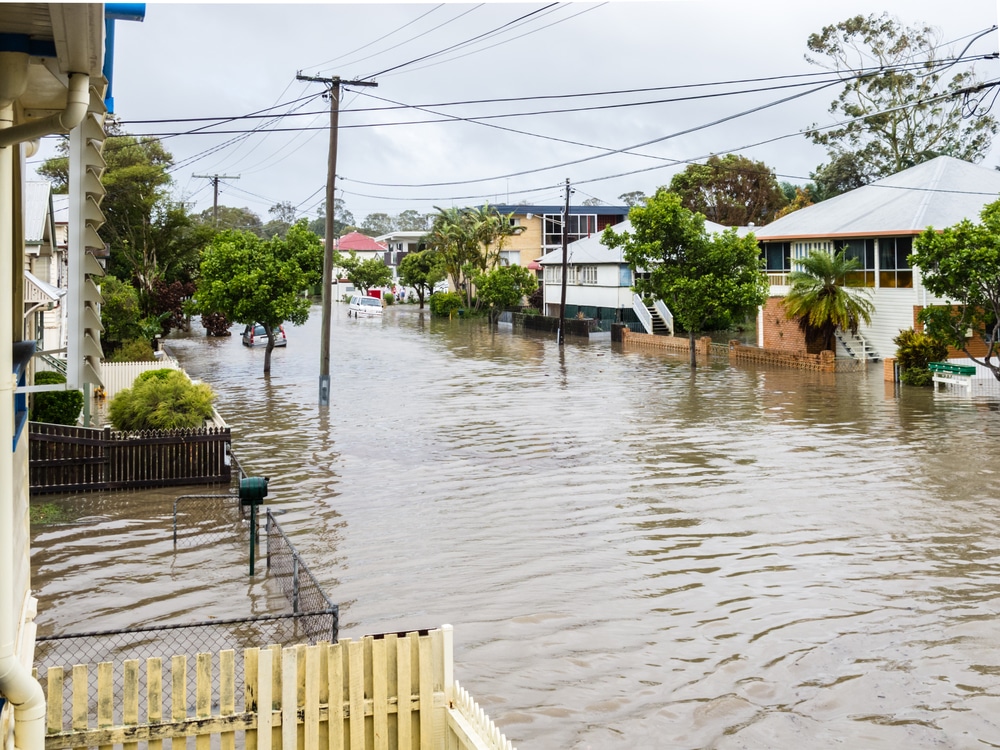
- The Savvy Promise
At Savvy, our mission is to empower you to make informed financial choices. While we maintain stringent editorial standards, this article may include mentions of products offered by our partners. Here’s how we generate income.
In this article
Savvy analyses the latest Climate Council data, showing an increasing number of properties in Australia will face skyrocketing home insurance premiums due to climate change related extreme weather events, including:
- Riverine flooding – when a river breaks its banks and floods
- Coastal inundation – when seawater floods an area
- Extreme wind – such as intense low-pressure systems or tropical cyclones
- Bushfires – destructive, out of control fires that spread through trees or forests
- Surface water flooding – often known as “flash flooding” after sustained heavy rainfall
Have you ever been confronted by the fact that where you live may make you…uninsurable? You may live on a bank of a river that’s prone to flooding; is directly in the path of cyclones; or in a place that gets tinder-dry in summer and are regularly threatened by bushfires.
Either way, insurance companies deem you too much of a risk to insure and deny your application for a home and contents premium.
According to a report by the Climate Council of Australia, “Across Australia approximately 520,940 properties, or one in every 25, will be ‘high risk’ and uninsurable. In addition, 9% of properties (1 in 11) will reach the ‘medium risk’ classification by 2030, with annual damage costs that equate to 0.2-1% of the property replacement cost. These properties are at risk of becoming underinsured.”
These are the Australian “uninsurables” – are you at risk of becoming one of them? What causes insurance companies to deem some areas too high of a risk? Where are the problem areas? We take a deep dive into the data.
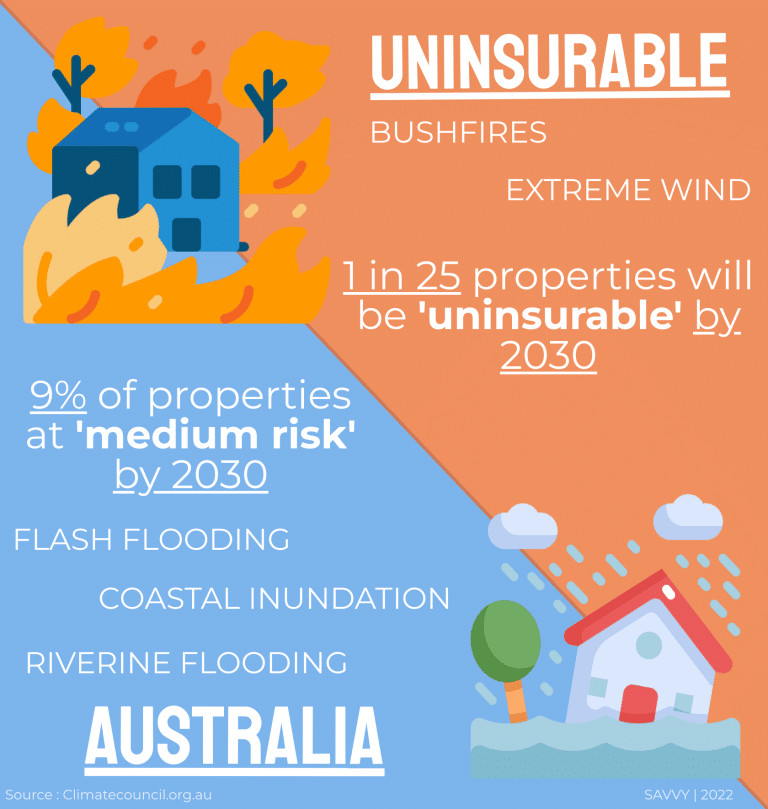
Uninsurable events – where risk outweighs affordability
Using a combination of modelling from the CSIRO, Universities of New South Wales and Queensland, the US National Oceanic and Atmospheric Administration, and data from Climate Valuation, we can derive what’s known as the Maximum to Date Value at Risk (MVAR) of extreme weather and climate hazards.
The MVAR is essentially the annual risk of damage to an asset. Properties with an MVAR in excess of 1% of the total replacement cost is considered “high risk” – and as such, insurance companies will either set premiums beyond what is normally affordable, effectively refusing to insure a dwelling.
Climate Valuation has extrapolated these extreme weather and climate hazards to the year 2030, 2050, and even 2100 using a set of data known as Climate Risk Engines. The Climate Risk Engine takes climate and weather data from a certain area and assumes each dwelling is a single storey detached house which uses recent design specifications and materials.
The total risk of hazards combines the likelihood of:
- Riverine flooding – when a river breaks its banks and floods
- Coastal inundation – when seawater floods an area
- Extreme wind – such as intense low-pressure systems or tropical cyclones
- Bushfires – destructive, out of control fires that spread through trees or forests
- Surface water flooding – often known as “flash flooding” after sustained heavy rainfall
Which then can be modelled on to specific areas.
The Top Australian Locations vulnerable to weather events
- Greater Shepparton, Victoria
Greater Shepparton, Moira, Campaspe, Mitchell, and parts of Strathbogie has the highest concentration of at-risk properties with 27.4% out of 94,280. Greater Shepparton is considered rural, though contains major regional centres such as Shepparton, which could be considered a regional urban area. 26.5% are at high risk of riverine flooding and 1.5% are at risk of surface water flooding.
The area has experienced massive floods, with major flooding events occurring in 1916, 1917, 1939, 1956, 1958, 1974, 1993 and 2010/11/12 in the Shepparton, Mooroopna and Murchison areas due to a flat topography.
By 2030, there will be 1,607 properties in this area at high risk for surface water flooding and a further 2,140 properties at ‘medium risk’.
- Tweed, Byron, Ballina, NSW
Bordering Queensland to the north, the Tweed-Byron-Ballina area includes major regional centres such as Byron Bay, Hastings Point, Tweed Heads, and Mullimbimby. Though once considered rural, these locations are becoming increasingly suburban. Of 106,455 properties, 20.9% are considered high risk.
14.5% are at high risk of riverine flooding, 5.2% are at high risk of bushfire exposure, and 0.4% of properties are at risk of surface water flooding.
Further, being in the Federal electorate of Richmond, these areas have lower than average incomes compared to the rest of the country. It suggests extreme weather events are being experienced by those who can least afford them.
- Maranoa River Area, Queensland
The Maranoa River area is bundled up into a regional electorate covering almost 750,000 square kilometres on the southwestern corner of Queensland. Towns located in Maranoa include Charleville, Cunnamulla, Dalby, Roma, Kingaroy, St George, Stanthorpe, Winton, and Warwick. As well as the Maranoa River, it’s also home to The Condamine-Balonne River system, one of the major tributaries of the Murray-Darling river system.
Of a total of 132,078 total properties, 14.8% are at high risk of extreme weather events. 13.9% are at high risk of riverine flooding, and 0.6% are at risk of bushfires.
In the regional town of St. George, it’s estimated that 70% of properties will be uninsurable due to flood risk by 2030.
- Lockyer Valley & Scenic Rim, Queensland
This area spans roughly 7,500 square kilometres of the Gold Coast hinterland, the area between Logan and the New South Wales border and the Lockyer Valley west of Ipswich.
Of 88,952 properties, 13.6% are at high risk. 9% of properties are at high risk of bushfire; 3.6% are at high risk of riverine flooding; 0.4% are at high risk of surface water flooding.
By 2030, the risk of fire will affect a significant number of the properties in the communities of Yarrabilba, Canungra, Greenbank, Kairabah, and Jimboomba.
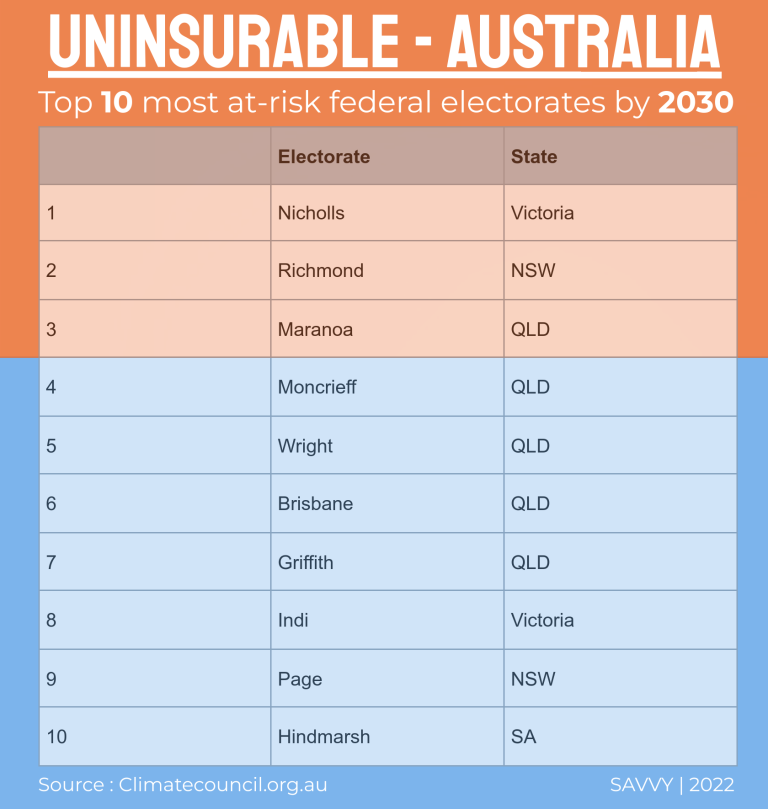
Bill Tsouvalas, Savvy home finance expert;
“This could have a massive flow on effect for house prices and gaining home finance in these areas, says finance expert and Savvy CEO Bill Tsouvalas. “No one will want to live in an uninsurable property and a lender will shy away from providing finance for it either – it could very well mean the death of some towns as they become uninhabitable from not just a climate perspective but economically.”
Future localities at risk
Climate risk is set to increase over the coming decades – and certain postcodes will be more “uninsurable” than others.
According to research published by the ABC, almost 20% of properties in the Alice Springs will be uninsurable by 2100, with similar numbers on the Sunshine and Gold Coasts. Mackay will be about 15% uninsurable, with Newcastle-Maitland being about 12% uninsurable over the same timeframe.
Did you find this page helpful?
Author
Adrian EdlingtonGuest Contributor
Bill TsouvalasPublished on August 31st, 2022
Last updated on March 15th, 2024
Fact checked
This guide provides general information and does not consider your individual needs, finances or objectives. We do not make any recommendation or suggestion about which product is best for you based on your specific situation and we do not compare all companies in the market, or all products offered by all companies. It’s always important to consider whether professional financial, legal or taxation advice is appropriate for you before choosing or purchasing a financial product.
The content on our website is produced by experts in the field of finance and reviewed as part of our editorial guidelines. We endeavour to keep all information across our site updated with accurate information.


